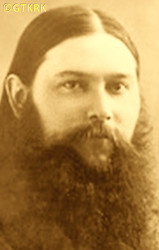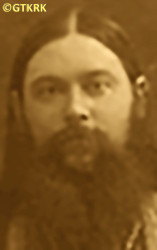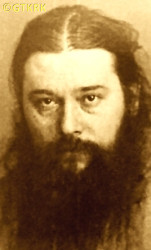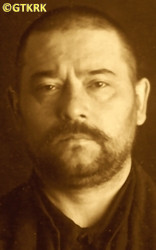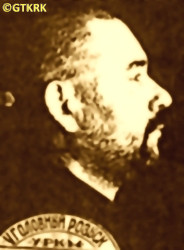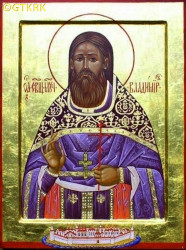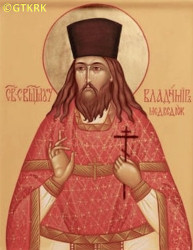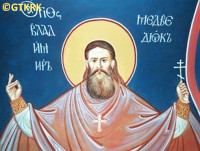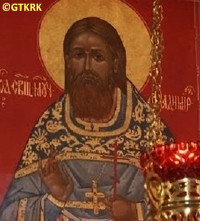Roman Catholic
St Sigismund parish
05-507 Słomczyn
85 Wiślana Str.
Konstancin deanery
Warsaw archdiocese, Poland
full list:
displayClick to display full list

searchClick to search full list by categories
wyświetlKliknij by wyświetlić pełną listę po polsku

szukajKliknij by przeszukać listę wg kategorii po polsku

Martyrology of the clergy — Poland
XX century (1914 – 1989)
personal data
religious status
saint
surname
MIEDWIEDIUK
forename(s)
Vladimir (pl. Włodzimierz)

canonisation date
14.08.2000

Council of Bishops of the Russian Orthodox Churchmore on
en.wikipedia.org
[access: 2020.09.24]
function
presbiter (i.e. iereus)
creed
Eastern Orthodox Church ORmore on
en.wikipedia.org
[access: 2014.09.21]
date and place
of death
03.12.1937

Butovotoday: Vidnoye reg., Moscow oblast, Russia
more on
en.wikipedia.org
[access: 2020.07.31]
details of death
During World War I after Russian defeat by German and Austro–Hungarian troops at battle of Gorlice in 05.1915, escaped with millions of Russian officials, teachers, military personnel, etc., i.e. members of the Russian administration in Russian–occupied Poland, deep into Russia (so‐called bezhenstvo).
For the first time arrested in 1925 in Moscow. Released after agreeing to collaborate with Russian criminal GPU organisation.
In 1929 broke out of the agreement.
On 09.12.1929 summoned to the GPU in Lublynka prison in Moscow and interrogated for three days — did not change his decision.
On 11.12.1929 arrested.
On 03.02.1930 sentenced by Russian criminal GPU kangaroo court — accused of „disclosing … information not subject to public disclosure”, i.e. providing his superiors in the Church with information about his secret cooperation with the GPU — to 3 years slave labour at concentration camps Gulag. His family was evicted from the house near the church where resided and found itself homeless in Moscow.
Slaved at White–Sea – Baltic canal construction, being held in ITL BelbaltLag concentration camp.
In 1932 released.
Settled in Zagorsk n. Moscow, continuing to minister in St Mitrophan of Voronezh church in Moscow.
In 1933 Russians shut the church down.
Finally arrested by the Russians on 25.11.1937 in Yazvishchi.
Accused of „counter revolutionary activities and anti–Russian agitattion”.
Did not plead guilty.
On 29.11.1936 sentence by a Russian genocidal kangaroo court know as «NKVD Troika» to death.
Murdered in a mass execution.
cause of death
mass murder
perpetrators
Russians
sites and events
11.08.1937 Russian genocideClick to display the description, Great Purge 1937Click to display the description, ButovoClick to display the description, ITL BelbaltLagClick to display the description, GulagClick to display the description, Moscow (Lubyanka)Click to display the description
date and place
of birth
15.07.1888

Łukówtoday: Łuków urban gm., Łuków pov., Lublin voiv., Poland
more on
en.wikipedia.org
[access: 2020.09.24]
parents
MIEDWIEDIUK Thaddeus
🞲 ?, ? — 🕆 ?, ?

🞲 ?, ? — 🕆 ?, ?
presbyter (holy orders)
ordination
1919

positions held
1933 – 1937
parish priest — Yazvishchetoday: Sychyovo, Volokolamsk reg., Moscow oblast, Russia
more on
ru.wikipedia.org
[access: 2024.03.02] ⋄ Life–giving Trinity OR church
1935
protoiereus (Eng. first priest) — Russian Orthodox Church
1932 – 1933
parish priest — Moscowtoday: Moscow city, Russia
more on
en.wikipedia.org
[access: 2020.07.31] ⋄ St Mitrophan of Voronezh OR church — till the church was closed by the Bolshevik authorities
1921 – 1929
parish priest — Moscowtoday: Moscow city, Russia
more on
en.wikipedia.org
[access: 2020.07.31] ⋄ St Mitrophan of Voronezh OR church — till imprisonment; in 1923 rewarded with the right to wear a kalimavkion, i.e. a special clerical headdress; in 1922 refused to hand over the keys to the church (take over) to representatives of the so‐called „Renovationism” (i.e. „Living Church”), a movement supported by the Bolsheviks but considered schismatic by the Patriarch of the Russian Orthodox Church, Tikhon
1919 – 1921
priest — Moscowtoday: Moscow city, Russia
more on
en.wikipedia.org
[access: 2020.07.31] ⋄ St Sabbas of Storozhi OR church
1919
presbiter (Eng. priest, i.e. iereus) — Russian Orthodox Church — priesthood cheirotonia, i.e. ordination
1916 – 1919
assistant — Moscowtoday: Moscow city, Russia
more on
en.wikipedia.org
[access: 2020.07.31] ⋄ St Irene the Martyr OR church
1916
deacon — Russian Orthodox Church — diaconate cheirotonia, i.e. ordination
1910 – 1915
psalmist — Radomtoday: Radom city pov., Masovia voiv., Poland
more on
en.wikipedia.org
[access: 2021.09.29] ⋄ St Nicholas OR parish
married — at least five children
others related
in death
CAKULClick to display biography Michael, KULHAWIECClick to display biography Simeon, NIKATOWClick to display biography Alex, SAWICKIClick to display biography Yaroslav, SIENKIEWICZClick to display biography Alex, STEPANIUKClick to display biography George, HUTKOClick to display biography Basil (Bp Ambrose), OSTROUMOWClick to display biography Michael (Bp Seraphim), GAGALUKClick to display biography Anthony (Abp Onuphrius), STROCIUKClick to display biography Leontius, BLUMOWICZClick to display biography John, SZACHMUĆClick to display biography Roman (Fr Seraphim), PANASIEWICZClick to display biography Emilian, SMOLENIECClick to display biography Alexander (Abp Arsenius), MARCENKOClick to display biography Alexander (Abp Anthony), BORZAKOWSKIClick to display biography Alexander (Abp Agapit), DIERNOWClick to display biography Anatol (Abp Abramius)
sites and events
descriptions
11.08.1937 Russian genocide: On 11.08.1937 Russian leader Stalin decided and NKVD head, Nicholas Jeżow, signed a «Polish operation» executive order no 00485. 139,835 Poles living in Russia were thus sentenced summarily to death. According to the records of the „Memorial” International Association for Historical, Educational, Charitable and Defense of Human Rights (Rus. Международное историко‐просветительское, правозащитное и благотворительное общество „Мемориал”), specialising with historical research and promoting knowledge about the victims of Russian repressions — 111,091 were murdered. 28,744 were sentenced to deportation to concentration camps in Gulag. Altogether however more than 100,000 Poles were deported, mainly to Kazakhstan, Siberia, Kharkov and Dniepropetrovsk. According to some historians, the number of victims should be multiplied by at least two, because not only the named persons were murdered, but entire Polish families (the mere suspicion of Polish nationality was sufficient). Taking into account the fact that the given number does not include the genocide in eastern Russia (Siberia), the number of victims may be as high as 500,000 Poles. (more on: en.wikipedia.orgClick to attempt to display webpage
[access: 2016.03.14])
Great Purge 1937: „Great Terror” (also «Great Purge», also called „Yezhovshchyna” after the name of the then head of the NKVD) — a Russian state action of political terror, planned and directed against millions of innocent victims — national minorities, wealthier peasants (kulaks), people considered opponents political, army officers, the greatest intensity of which took place from 09.1936 to 08.1938. It reached its peak starting in the summer of 1937, when Art. 58‐14 of the Penal Code about „counter‐revolutionary sabotage” was passed , which became the basis for the „legalization” of murders, and on 02.07.1937 when the highest authorities of Russia, under the leadership of Joseph Stalin, issued a decree on the initiation of action against the kulaks. Next a number of executive orders of the NKVD followed, including No. 00439 of 25.07.1937, starting the liquidation of 25,000‐42,000 Germans living in Russia (mainly the so‐called Volga Germans); No. 00447 of 30.07.1937, beginning the liquidation of „anti‐Russian elements”, and No. 00485[2] of 11.08.1937, ordering the murder of 139,835 people of Polish nationality (the latter was the largest operation of this type — encompassed 12.5% of all those murdered during the «Great Purge», while Poles constituted 0.4% of the population). In the summer of 1937 Polish Catholic priests held in Solovetsky Islands, Anzer Island and ITL BelbaltLag were locked in prison cells (some in Sankt Petersburg). Next in a few kangaroo, murderous Russian trials (on 09.10.1937, 25.11.1937, among others) run by so‐called «NKVD Troika» all were sentenced to death. They were subsequently executed by a single shot to the back of the head. The murders took place either in Sankt Petersburg prison or directly in places of mass murder, e.g. Sandarmokh or Levashov Wilderness, where their bodies were dumped into the ditches. Other priests were arrested in the places they still ministered in and next murdered in local NKVD headquarters (e.g. in Minsk in Belarus), after equally genocidal trials run by aforementioned «NKVD Troika» kangaroo courts.
Butovo: Russian genocidal NKVD shooting range n. Moscov. From 08.08.1937 place of mass executions (during Great Purge). Till 19.10.1938 there were murdered 20,765 people (95.86% men), including 1,176 Poles — according to fragmentary available data. Among the executed were 739 Russian Orthodox priests, including 7 bishops and Metropolitan bishops with 81 years old Metropolitan bishop Seraphim Chichagov, today the saint of Orthodox church (this church canonised 255 of the victims), and Lutheran and Protestant pastors and Catholic priests, mainly from Poland and Austria. Place known today and „Russian Golgotha”. (more on: en.wikipedia.orgClick to attempt to display webpage
[access: 2020.07.31])
ITL BelbaltLag: Russian Rus. Исправи́тельно‐Трудово́й Ла́герь (Eng. Corrective Labor Camp) ITL Rus. Беломоро‐Балтийский (Eng. White Sea ‐ Baltic Sea) — concentration and slave forced labor camp (within the Gulag complex) — headquartered in Medvezhjegorsk on Lake Onega, and in 1933‐1934 also in the town of Nadvoytsy (both then in the Karelo‐Finnish Republic, today the Karelian Republic). Founded on 16.11.1931, on the basis of the former ITL SLON camp (i.a. on the Solovetsky islands on the White Sea). Prisoners slaved at the construction of a canal between the White Sea and the Baltic Sea (opened on 30.06.1933). Later, as part of the newly created White Sea ‐ Baltic Sea Combine, managed by the criminal GPU (later the genocidal NKVD), slaved on forest clearing, in sawmills, on the construction of factories for wooden products and paper production, on the construction of hydroelectric power plants (Tulomskaya and Onda), a nickel factory and alcohol distilleries, construction of ports, and laying of railway lines., etc. One of heads of the camp was a Jew, Naftali Frenkel, regarded as the originator of the Gulag system. At its peak c. 110,000 prisoners were held there: e.g. 107,900 (12.1932); 70,373 (01.01.1934); 66,418 (01.01.1935); 90,290 (01.01.1936); 58,965 (01.01.1937); 79,232 (01.10.1938); 86,567 (01.01.1939); 71,269 (01.01.1941); 67,928 (15.06.1941). In 1938 there were 3,946 women among them. According to official data, 12,300 perished during the construction of the canal itself — according to unofficial data, from 50,000 to 300,000. The camp operated until 18.09.1941, and the entire project — in economic terms — turned out to be a total failure. (more on: ru.wikipedia.orgClick to attempt to display webpage
[access: 2022.09.02], en.wikipedia.orgClick to attempt to display webpage
[access: 2014.05.09])
Gulag: The acronym Gulag comes from the Rus. Главное управление исправительно‐трудовых лагерей и колоний (Eng. Main Board of Correctional Labor Camps). The network of Russian concentration camps for slave labor was formally established by the decision of the highest Russian authorities on 27.06.1929. Control was taken over by the OGPU, the predecessor of the genocidal NKVD (from 1934) and the MGB (from 1946). Individual gulags (camps) were often established in remote, sparsely populated areas, where industrial or transport facilities important for the Russian state were built. They were modeled on the first „great construction of communism”, the White Sea‐Baltic Canal (1931‐1932), and Naftali Frenkel, of Jewish origin, is considered the creator of the system of using forced slave labor within the Gulag. He went down in history as the author of the principle „We have to squeeze everything out of the prisoner in the first three months — then nothing is there for us”. He was to be the creator, according to Alexander Solzhenitsyn, of the so‐called „Boiler system”, i.e. the dependence of food rations on working out a certain percentage of the norm. The term ZEK — prisoner — i.e. Rus. заключенный‐каналоармец (Eng. canal soldier) — was coined in the ITL BelBaltLag managed by him, and was adopted to mean a prisoner in Russian slave labor camps. Up to 12 mln prisoners were held in Gulag camps at one time, i.e. c. 5% of Russia's population. In his book „The Gulag Archipelago”, Solzhenitsyn estimated that c. 60 mln people were killed in the Gulag until 1956. Formally dissolved on 20.01.1960. (more on: en.wikipedia.orgClick to attempt to display webpage
[access: 2024.04.08])
Moscow (Lubyanka): Location of a murderous Russian Cheka and next GPU and NKVD (later MVD and KGB) organisations and a prison (in the basement, with 118 cells — in 1936 — of which 94 were solitary — altogether at any time up to 350 prisoners were held there and c. 2,857 in 1937) in Moscow at Lubyanka Square where Russians interrogated and murdered many political prisoners. Most of the prisoners after investigations were transferred to other Moscov prisons, e.g. Butyrki. (more on: en.wikipedia.orgClick to attempt to display webpage
[access: 2014.10.31])
sources
personal:
ru.wikipedia.orgClick to attempt to display webpage
[access: 2020.09.24], days.pravoslavie.ruClick to attempt to display webpage
[access: 2020.09.24], drevo-info.ruClick to attempt to display webpage
[access: 2020.09.24], ru.openlist.wikiClick to attempt to display webpage
[access: 2024.03.02]
bibliographical:
„Hierachy, clergy and employees of the Orthodox Church in the 19th‐21st centuries within the borders of the Second Polish Republic and post–war Poland”, Fr Gregory Sosna, M. Antonine Troc-Sosna, Warsaw–Bielsk Podlaski 2017
original images:
ru.wikipedia.orgClick to attempt to display webpage
[access: 2020.09.24], kalendar.blagodrevo.comClick to attempt to display webpage
[access: 2020.09.24], drevo-info.ruClick to attempt to display webpage
[access: 2020.09.24], polit.ruClick to attempt to display webpage
[access: 2020.09.24], www.solovki.caClick to attempt to display webpage
[access: 2020.09.24], героиверы.рфClick to attempt to display webpage
[access: 2020.09.24], azbyka.ruClick to attempt to display webpage
[access: 2020.09.24], hram-goretovo.ruClick to attempt to display webpage
[access: 2020.09.24], proza.ruClick to attempt to display webpage
[access: 2020.09.24]
LETTER to CUSTODIAN/ADMINISTRATOR
If you have an Email client on your communicator/computer — such as Mozilla Thunderbird, Windows Mail or Microsoft Outlook, described at WikipediaPatrz:
en.wikipedia.org, among others — try the link below, please:
LETTER to CUSTODIAN/ADMINISTRATORClick and try to call your own Email client
If however you do not run such a client or the above link is not active please send an email to the Custodian/Administrator using your account — in your customary email/correspondence engine — at the following address:

giving the following as the subject:
MARTYROLOGY: MIEDWIEDIUK Vladimir
To return to the biography press below:
 Click to return to biography
Click to return to biography








